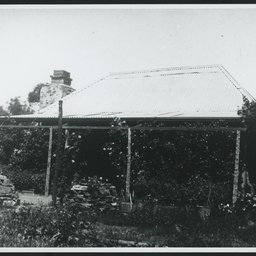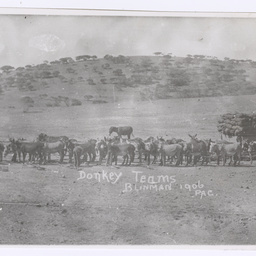Find • blinman • Results 61 to 90 of 215


Blinman
BLINMAN: A group of Aboriginal people at Patta Werta.


Blinman
Panoramic view of Blinman.


Blinman
View from the south of Blinman.


The Blinman Mine
The Blinman Mine.


Royal Mail Coach, Blinman
Royal Mail Coach near Angorichina en route from Parachilna to Blinman.


Dwelling, Blinman
Pug and Pine house on Main Street, Blinman.


William's Store, Blinman
William's store on Main Street, Blinman the family are grouped outside on the verandah.


The Blinman School
The Blinman School.


Picnic, Blinman
Blinman townspeople starting out in horse wagons on a picnic from outside the Town Hall.


Blinman
Street scene at Blinman.


Blinman
Four views of Blinman.


Blinman
Distant view of the township of Blinman.


Camel Train, Blinman
Camel train carrying goods leaving south from Blinman.


Blinman
Main Street of Blinman with the Police station in the foreground.


Blinman
Buildings at Blinman including the hotel and the Shell service station.


Cornish graves, Blinman
Graves of Cornish miners in the Blinman cemetery.


Robert Blinman and Family
Robert Thomas Blinman (1810-1880) with his wife Hannah, nee Hunt and their son William (born 1847) and daughter Ellen Joan Jacobs Blinman (born 1854). Robert Blinman's wooden leg is visible.


Blinman
Horse and carriage in the street of Blinman in 1897-8. Blinman was named after the shepherd, Robert Blinman ("Pegleg" due to a wooden leg) who discovered copper in the area. The subsequent mine and miners made the settlement into a thriving township. Surveyer Thomas Evans laid out 162 allotments and named the town Blinman


Dorrie Canning on Memorial Hill, Blinman
Dorrie Canning sitting on a stone at Memorial Hill, Blinman, with her dog "Tiger" beside her. In the background is the cairn built by Blinman school children to honour their fallen soldiers of 1914.


Monument, Blinman
Cairn erected by schoolchildren to commemorate WWI.


Camel carriage, Blinman
Mr. J. V. Whyte's camel in single harness outside J.E. Jones general store.


Wool wagons, donkeys and horses
BLINMAN: Wool wagons, donkeys, and horses on the road near to Blinman.


A young girl on a camel
BLINMAN: A young girl called Irene sitting on a camel resting by farm sheds at a property near Blinman.


Men and women sitting under a tree
BLINMAN: A group of Aboriginal and white men and women resting with their dogs under the shade of a tree at Blinman.


J. E. Jones' Store, Blinman
J. E. Jones' general store and saddler's shop.


Goat Cart, Blinman
Goat cart loaded with wood.


Wirrealpa Station, Blinman
Carting wool at Wirrealpa Station. The International (or Thornycroft?) vehicle was used by Tom Kruse to carry the Birdsville mail. l-r Tom Edwards, Curly Kruse, Tom Kruse, Mr. Edwards and Max White.


Donkey teams at Blinman
Donkey teams carting wool bales.


Mining, Blinman
Tunnel into open cut mine - 5ft high, 65 yards long.


Mining at Blinman
Open cut copper mine.
